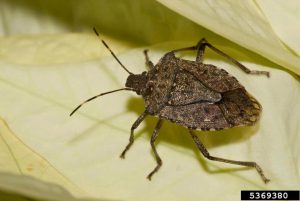The cooler weather is going to send insects scrambling for warm, safe places to spend the winter. Unfortunately for us, our houses are exactly what these bugs are looking for. One of the peskiest invaders is the Brown Marmorated Stink Bug (BMSB). This bug was introduced from Asia most likely in shipping crates. The first recorded sighting was in Allentown, Pennsylvania in 1998, but it probably arrived even before that. It has subsequently spread throughout much of the east coast, feeding on crops and becoming a nuisance in winter.
The adult BMSB is about 17 mm long and has a mottled brown pattern. It has light colored bands on its antenna and alternating light and dark brown bands on the edge of its body. Like many other stink bugs, it is shaped like a shield and as its name suggests, it has glands that produce an unpleasant odor when it is agitated. There are usually only one or two generations in Georgia, depending on how warm the weather is and the location. Adults emerge in May, mate and deposit eggs throughout the summer. The nymphs emerge from the eggs and go through five growth stages before finally developing wings and becoming adults. By this time, temperatures start to cool off, and the bugs search for places to overwinter until October.
 Brown Marmorated Stink Bug Adult
Brown Marmorated Stink Bug Adult
Susan Ellis, Bugwood.org
In its native range in Asia, the BMSB feeds on a wide variety of fruit including apples, pears, peaches, figs, citrus, and many others. It can also be a pest of ornamental plants and important crops such as soybeans. In the Northeastern United States, this bug has caused massive damage to apple and berry orchards. In the Southeast, it can be a major pest of cotton and blueberries, two very important crops to Georgia.
Though you may find several of these insects in your house over the winter, they do not infest houses like cockroaches. You will typically find them squeezing through door jams and window frames as they follow the light they see coming from your house, and then sense the warm temperatures. The best way to make sure these smelly pests don’t completely take over in the winter is to take action before they look for warm spaces. This means making sure all outdoor vents are covered with a fine mesh, adding weather stripping to door and window frames, and sealing up any other points of entry. Though you may still see some bugs in late fall and winter, having your house sealed up well will decrease the number of BMSB that make it in.
You may be tempted to spray insecticide if you see BSMB in your home, but once they make it inside, your best bet would be to try to locate where they came in. If you have a lot of bugs in walls or attic spaces, spraying insecticides will indeed kill many of them, but it won’t prevent more from moving in. Also, having a large amount of dead stink bugs in your home will promote carpet beetle infestations, as they feed on dead insects. Carpet beetles also feed on wool clothing and other animal products, so it is best to try to prevent stink bugs from entering in the first place.
Though these pesky critters can be annoying and give off a bad smell, they are not harmful. They may startle you as they fly around your house, but they won’t bite, sting, or infest your home, so don’t worry too much. Just seal up your house to try to avoid the problem next year!